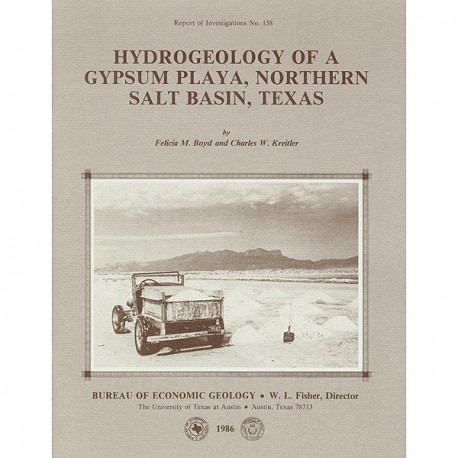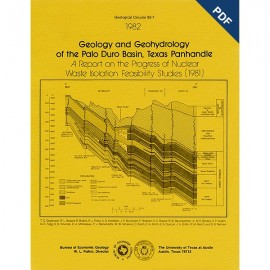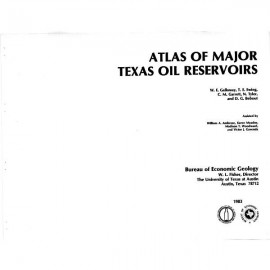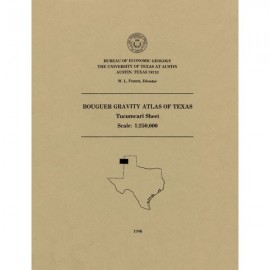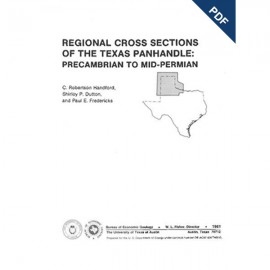Reports of Investigations
-
Books & Reports
- Reports of Investigations
- Guidebooks
- Udden Series
- Geological Circulars
- Down To Earth
- Atlases of Major Oil and Gas Reservoirs
- Texas Memorial Museum Publications
- Environmental Geologic Atlas of the Texas Coastal Zone
- Mineral Resource Circulars
- Other Reports
- Seminars and Workshops
- Handbooks
- Submerged Lands of Texas
- Symposia
- Annual Reports
- Open File Reports
-
Maps & Cross Sections
- Thematic Maps
- Miscellaneous Maps, Charts & Sections
- Geologic Atlas of Texas
- STATEMAP Project Maps
- Geologic Quadrangle Maps
- Cross Sections
- Highway Geology Map
- Energy and Mineral Resource Maps
- Shoreline Change and Other Posters
- Wilcox Group, East Texas, Geological / Hydrological Folios
- Bouguer Gravity Atlas of Texas
- River Basin Regional Studies
- Featured Maps
- Posters
- Teachers & the Public
-
Geological Society Publications
- Gulf Coast Association of Geological Societies
- Alabama Geological Society
- Austin Geological Society
- Corpus Christi Geological Society
- Houston Geological Society
- Lafayette Geological Society
- Mississippi Geological Society
- New Orleans Geological Society
- South Texas Geological Society
- GCS SEPM Publications
- Historic BEG & UT Series
RI0158. Hydrogeology of a Gypsum Playa, Northern Salt Basin, Texas, by F. M. Boyd and C. W. Kreitler. 37 p., 24 figs., 4 tables, 1 appendix, 1986. ISSN: 0092335X: Print.
To purchase this publication as a downloadable PDF, please order RI0158D.
ABSTRACT
The northern Salt Basin in West Texas and New Mexico is a closed hydrologic system in which discharge of ground-water flow occurs in a series of playas, or salt flats. Ground water originating in peripheral consolidated rocks and alluvial fans flows toward the center of the basin and discharges by evaporation from the salt flats. Progressive increases in salinity are characteristic of the waters moving down gradient and are primarily attributed to evaporative concentration. Steady increases in sodium (Na+) and chloride (Cl-) and, to a lesser degree, magnesium (Mg+2) and potassium (K+) characterize increases in total dissolved solids (TDS). Intense evaporation above the water table in the salt flats concentrates the composition of brine to TDS values that range from 50,000 mg/L to greater than 300,000 mg/L. Precipitation of minerals from solution, primarily alkaline earth carbonates and gypsum, results in depletion of calcium (Ca+2) and bicarbonate (HCO3-) and relative enrichment of sulfate (SO4-2) in the ground water. Inflowing ground water of a Ca-Mg-SO4 composition undergoes evaporation and evolves to a final composition of a Na-Mg- SO4-Cl brine in the salt flats. Gypsum currently precipitates in the salt flats at a depositional rate that ranges from 0.02 to 0.09 cm/yr. These deposits do not likely represent relict lakebed sediments.
Evaporative concentration and mineral precipitation are the most important processes in the basin and flats that affect the composition of the shallow subsurface fluids. However, the chemistry of the brines in the salt flats is occasionally modified by surface water that ponds on the playa surface and percolates downward.
Keywords: gypsum, hydrogeology, Salt Basin, Trans-Pecos Texas, water chemistry
CONTENTS
ABSTRACT
INTRODUCTION
Geologic setting
Geomorphic setting
HYDROLOGY
Recharge
Movement
Discharge
PLAYA CHARACTERISTICS
Playa surfaces and microrelief structures
SHALLOW SUBSURFACE STRATIGRAPHY
MINERALOGY
HYDROCHEMISTRY
Data base and analytical methods
Results
DISCUSSION
Brine chemistry evolution
Gypsum and halite
CONCLUSIONS
ACKNOWLEDGMENTS
REFERENCES
APPENDIX: History of salt mining at the salt lakes
Figures
1. Location of the northern Salt Basin
2. Zimpleman Salt Lake
3. Structure map of the northern and central Salt Basin
4. Geomorphic features
5. Location of wells and test holes sampled for this study or for which chemical analyses were available
6. Map of the potentiometric surface of the northern and north-central Salt Basin 7. Playa surfaces of the northern Salt Basin
8. Shallow sediments beneath the playa surface
9. SEM photographs of playa crusts
10. Occurrence of gypsum
11. a. Section A-A'. Ground-water chemical composition from the Delaware Mountains and associated fans to the salt flats.11b. Section B-B'. Ground-water chemical composition from Dell City to the salt flats. 11c. Section C-C'. Ground-water chemical composition from Sierra Diablo Plateau and associated alluvial fans to the salt flats. 11d. Section D-D'. Ground-water chemical composition within the salt flats
12. Piper diagrams of chemical composition of ground waters from the Salt Basin
13. Saturation potential for gypsum
14. Cl- versus TDS
15. Na+ versus K+
16. Na+/Cl versus TDS
17. Brine evolution and mineral precipitation sequence
18. Ca+2/HCO3-versus TDS
19. Ca+2 versus TDS
20. HCO3- versus TDS
21. Ca+2/SO4-2 versus TDS
22 SO4-2 versus TDS
23. Mg +2/SO4-2 versus TDS
24. Flooding of the salt flats, summer 1981
Tables
1. Geologic and hydrologic characteristics, Northern Salt Basin and surrounding highlands
2. Water levels of wells and test holes, northern Salt Basin
3. Chemical analyses of waters, northern Salt Basin
4. Chemical analyses of Salt Flat pore waters
Citation
Boyd, F. M., and Kreitler, C. W., 1986, Hydrogeology of a Gypsum Playa, Northern Salt Basin, Texas: The University of Texas at Austin, Bureau of Economic Geology, Report of Investigations No. 158, 37 p.
